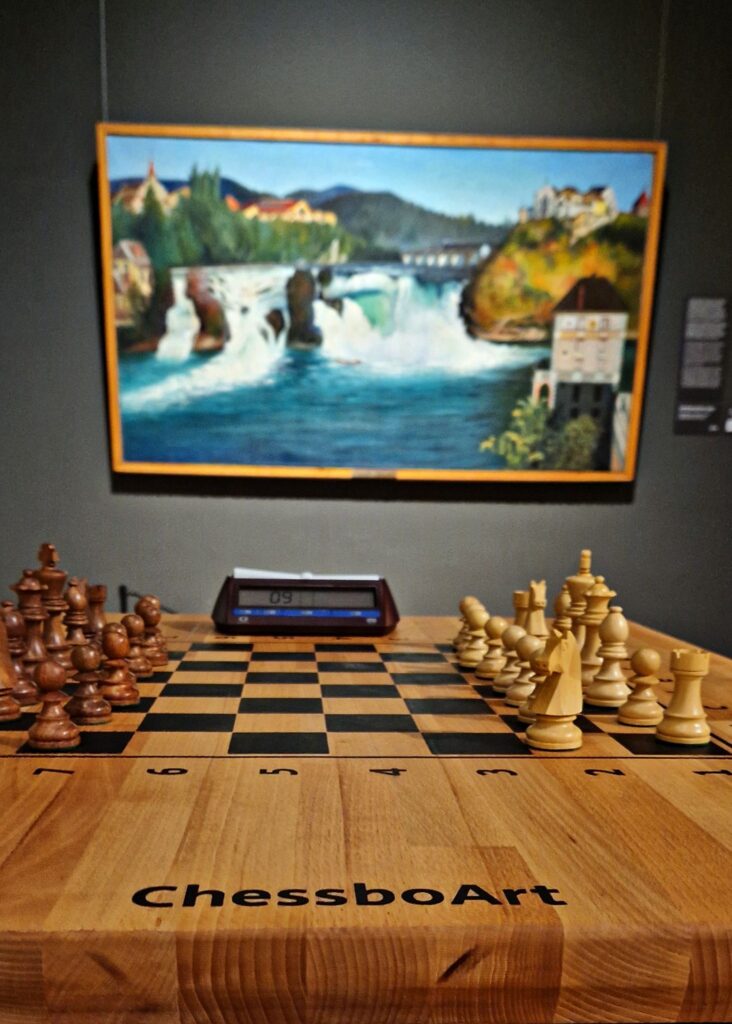Modern interiors want objects that do more than decorate. A vertical, wall-mounted chessboard turns geometry into a piece of living art: a regulation layout you can actually play, engineered with magnets and crafted like fine furniture. This long-form guide explains what makes a vertical magnetic chess board work, which materials suit different aesthetics, how to size and mount it, and how collectors commission one-off pieces that hold their value.
What “vertical chess” is — and why it matters
A short definition
A vertical chessboard is a wall-mounted, magnetic chess board designed for real play. Pieces grip the surface via a calibrated magnet system; the face is perfectly level and finished like gallery furniture. It’s functional art: sculpture you can interact with every day.
Why collectors and designers love it
- Always set up: walk up, make a move, resume a saved position tomorrow.
- Space-smart: perfect for apartments, studios, hallways and offices.
- Conversation piece: a visual anchor that signals taste and invites participation.
- Educational: coaches and parents use it for live demonstrations.
Reading experience: proportion, contrast, distance
Square size vs viewing distance
From typical living-room distances of 2–3 m, choose 50–56 mm squares. In spacious halls or long corridors, 56–60 mm improves legibility; in small studies 45–50 mm can work, but resist going smaller for adult play.
Notation and layout
Discreet coordinates (A–H, 1–8) help with study and streaming. The font should be calm and high-contrast. Frames ought to behave like picture frames—elegant, not bulky—so the board itself remains the star.
Contrast that reads like print
Contrast is everything for readability at distance. Classic pairs include walnut vs pearl-white, ash vs black, oak vs deep brown. Semi-matte finishes reduce glare under spotlights and camera lights.
The engineering behind vertical boards
Magnets: board + pieces (not one or the other)
Premium builds embed a dense grid of neodymium magnets in the board and pair it with magnetised pieces. This tuning creates a gentle “grid snap” and strong shear resistance (resistance to downward slide), which matters more than raw pull force.
One perfectly level plane
After CNC engraving and inlay or pour, the entire face is sanded to a single plane. That’s why pieces lift quietly without clacking and why you don’t see “halos” around magnets. Levelness is the heart of a credible wall board.
Longevity and service
Hidden cleats allow lift-off servicing. Hardware is over-spec’d for load and comes with anti-tilt stabilisers so the board hangs flat through seasons.
Materials and finish: selecting a visual language
Epoxy resin inlays (contemporary)
Process: CNC pockets → epoxy pour → full-surface sanding → hand finish.
Result: a glass-flat surface with permanent contrast and wipe-clean practicality. Pearl white and deep black are classics; midnight blue or subtle gold dust suit galleries and hospitality spaces.
Wood inlay / intarsia (timeless)
Walnut with maple (or ash/oak pairings) gives a tactile, museum-grade look. Oil/wax finishes create depth and a warm, hand-rubbed sheen that ages gracefully.
Metal face (robust & educational)
Powder-coated metal boards are rugged and light, perfect for schools and club annexes. They sacrifice some furniture-grade romance but win on durability and price.
Choosing the finish
- Oil/wax: warm, reparable, natural.
- Satin varnish: camera-friendly, wipe-fast, low glare.
- Hardwax: quick application, soft semi-matte sheen.
Mounting and safety (drywall, brick, plaster)
Hardware and load path
Use discreet hangers rated far above the board’s mass; a French-cleat rail spreads load, simplifies levelling and allows easy removal. Anti-tilt pads keep the bottom edge true to the wall.
Wall types and best practice
- Stud/drywall: bolt into studs or use rated anchors; avoid mere picture nails.
- Brick/concrete: wall plugs + screws; pre-drill carefully to avoid spalling.
- Historic plaster: distribute load via a cleat and avoid brittle zones.
Eye-line and alignment
A centre height of 140–160 cm feels natural. In children’s rooms drop the centreline; in galleries coordinate top lines with adjacent frames for a clean sight line.
Curating the look: four interior styles
Minimal / Scandinavian
Walnut + pearl-white resin, thin profile frame, satin finish. Pair with linen textures and soft, indirect lighting.
Modern loft
Ash or oak with deep black resin; black steel accents echo window mullions. Works beautifully near a reading chair—people will get up and play.
Classic library
Maple/walnut inlay, warm oil, brass picture lights. The board reads like a historic instrument rather than a gadget.
Hospitality and offices
Two boards facing a breakout space encourage collaboration. Choose semi-matte finishes to control reflections and specify magnets tuned for frequent handling.
Provenance, signatures and the collector mindset
Documentation
High-craft studios deliver a signed plate, edition number and material notes. Keep these with photographs of the work in situ; they form the nucleus of provenance for future valuation.
Conservation
Dust lightly with a soft cloth; avoid harsh solvents. Oil/wax surfaces benefit from a gentle refresh once or twice a year. Check hanger screws annually, as you would with framed art.
Commissioning a bespoke wall-mounted chessboard

The brief
State the wall size, primary viewing distance, light temperature (Kelvin), existing wood tones and any palette constraints. Decide whether coordinates should be visible on camera or almost invisible in person.
Design choices that matter
- Square size: 50–56 mm for 2–3 m viewing; larger for long sight lines.
- Contrast: test swatches under your actual lighting.
- Frame: gallery-style frame vs hidden edge; both change how the object reads.
- Pieces: magnet strength tuned to the board—ask for a set that matches the intended use (kids vs collectors vs clubs).
The build process
CNC precision cuts the geometry; inlay or epoxy establishes contrast; the entire face is sanded to a uniform plane; finish is adjusted to the interior (oil/wax warmth vs satin varnish). Hardware is fitted and tested before shipping.
Case notes: three real-world placements
Apartment study, 2.4 m viewing distance
A 52 mm walnut/pearl-white board in a narrow hallway turned a dead zone into a daily ritual. The owner saves a favourite endgame each night and resumes it with coffee.
Café corner, mixed daylight and warm LEDs
An ash/black resin board with satin varnish delivered strong contrast and low glare for social play and photos. The café runs a “move of the day” challenge on a chalkboard beside it.
Corporate lounge, streaming backdrop
Two vertical boards at 56 mm work as a symmetrical set behind a sofa. Engraved notation aids live teaching; cable routing hides any camera power leads.
Gifting: ten ideas that make a chess lover melt
- Engraved dedication and date.
- Coordinates of where you met or won your first tournament.
- Resin colour matched to a favourite painting.
- Custom pieces in a complementary tone.
- Limited edition number and signed backplate.
- A pre-set composition (mate in two by a favourite composer).
- Subtle club or family crest on the reverse.
- Companion photo of a memorable game framed under the board.
- Lesson cards for parents to teach kids.
- A certificate of provenance in a small, archival folder.
Purchasing checklist (print-friendly)
- Viewing distance and square size chosen for the room.
- High-contrast pair that reads at 2–3 m.
- Magnet grid in the board + magnetised pieces tuned for shear resistance.
- One-plane face, sanded after inlay/pour.
- French-cleat mounting with anti-tilt pads; fasteners rated for load.
- Finish selected for light and cleaning routine (oil/wax vs satin varnish).
- Signed/numbered documentation stored safely.
FAQ
Will pieces slide down?
Not if the board uses a dense magnet grid and pieces are magnetised and calibrated for shear resistance. A perfectly level face completes the system.
Epoxy or wood inlay?
Epoxy is wipe-clean and crisply modern; wood inlay is tactile and timeless. Both are legitimate, museum-grade approaches when the surface is levelled as one plane.
Can I relocate the board?
Yes. French-cleat mounting lets you lift the board off, move it, and re-hang using fresh wall anchors.
What size suits a long corridor?
56–60 mm squares read beautifully across distance. Pair with a satin finish to tame glare from linear fixtures.
Do I need coordinates?
If you teach, stream or study tactics from the sofa, coordinates help. For a pure art statement, omit them and keep the face ultra-calm.
Where to explore and commission
If the idea of playable sculpture speaks to you, explore the work of ChessboArt — a studio focused on vertical chessboards built to gallery standards with CNC precision, calibrated magnets and hand finishes. You can choose a ready model or commission a one-off tailored to your wall, lighting and palette.

